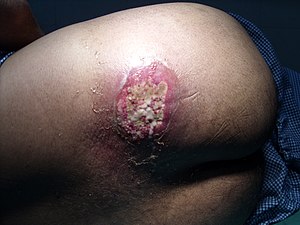Carbuncles
| Carbuncle | |
|---|---|
 |
|
| Carbuncle on buttock of a diabetic person | |
| Pronunciation | /ˈkɑːbʌŋkəl/ or /ˈkɑːrbʌŋkəl/ |
| Classification and external resources | |
| Specialty | Dermatology |
| ICD-10 | L02 |
| ICD-9-CM | 680.9 |
| DiseasesDB | 29434 |
| MedlinePlus | 000825 |
| MeSH | D002270 |
A carbuncle is a cluster of boils, draining pus onto the skin. It is usually caused by bacterial infection, most commonly with Staphylococcus aureus or , which can turn lethal. However, the presence of a carbuncle is actually a sign that the immune system is active and fighting the infection responsible for the carbuncle. The infection is contagious and may spread to other areas of the body, or other people; those living in the same residence may develop carbuncles at the same time.
A carbuncle is made up of several skin boils. The infected mass is filled with fluid, pus and dead tissue. Fluid may drain out of the carbuncle, but sometimes the mass is so deep that it cannot drain on its own. Carbuncles may develop anywhere, but they are most common on the back and the nape of the neck.
The carbuncle may be the size of a pea or as large as a golf ball. It may be red and irritated, and might hurt when touched. It may also grow very fast and have a white or yellow center. It may crust or spread to other skin areas. Sometimes other symptoms may occur, such as fatigue, fever and a general discomfort or sick feeling. Itching may occur before the carbuncle develops.
The initial cause of a carbuncle can often not be determined. Triggers that make carbuncle infections more likely include rashes such as folliculitis; friction from clothing or shaving; having hair pulled out, such as sites where clothing or furniture grab at hairs; generally poor hygiene; poor nutrition; or weakening of immunity. Poor health may be an important factor – for example, persons with diabetes and immune system diseases are more likely to develop infections (especially bacterial infections of the leg or foot).
...
Wikipedia
